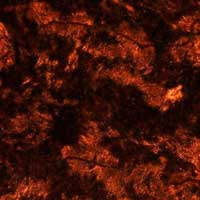 When indented by a probe in darkness, wafers of some semiconductors are putty-like. When illuminated by light whose wavelength matches the band gap, they become hard, as electrons and holes freed by the light suppress the propagation of dislocations.
When indented by a probe in darkness, wafers of some semiconductors are putty-like. When illuminated by light whose wavelength matches the band gap, they become hard, as electrons and holes freed by the light suppress the propagation of dislocations.
Friday, March 5, 2021
Light in concert with force reveals how materials become harder when illuminated
 When indented by a probe in darkness, wafers of some semiconductors are putty-like. When illuminated by light whose wavelength matches the band gap, they become hard, as electrons and holes freed by the light suppress the propagation of dislocations.
When indented by a probe in darkness, wafers of some semiconductors are putty-like. When illuminated by light whose wavelength matches the band gap, they become hard, as electrons and holes freed by the light suppress the propagation of dislocations.
Retinal implants can give artificial vision to the blind (w/video)
 Researchers have developed a new type of retinal implant for people who have become blind due to the loss of photoreceptor cells in their retinas. The implant partially restores their visual field and can significantly improve their quality of life.
Researchers have developed a new type of retinal implant for people who have become blind due to the loss of photoreceptor cells in their retinas. The implant partially restores their visual field and can significantly improve their quality of life.
Holographic nanostructures on CMOS sensors for energy-efficient AI security schemes
 Researchers have realized an AI optical circuit, with a neural density equal to 1/400 of human brain. The circuit is trained to process information through unpowered all-optical inference at the speed of light with a computational power more than ten orders of magnitude larger than electronic processors. In future, its neural density is expected to be 10 times that of human brain.
Researchers have realized an AI optical circuit, with a neural density equal to 1/400 of human brain. The circuit is trained to process information through unpowered all-optical inference at the speed of light with a computational power more than ten orders of magnitude larger than electronic processors. In future, its neural density is expected to be 10 times that of human brain.
Taking 2D materials for a spin
 Scientists fabricate a novel molybdenum disulfide transistor and create an image of the spins of the electrons passing through which may open the way for new spintronic computers.
Scientists fabricate a novel molybdenum disulfide transistor and create an image of the spins of the electrons passing through which may open the way for new spintronic computers.
Compression or strain - this 2D material expands always the same
 Researchers have discovered a new two-dimensional material with unprecedented properties: regardless if it is strained or compressed, it always expands. This so-called half-auxetic behavior has not been observed before and is therefore very promising for the design of new applications, especially in nano-sensorics.
Researchers have discovered a new two-dimensional material with unprecedented properties: regardless if it is strained or compressed, it always expands. This so-called half-auxetic behavior has not been observed before and is therefore very promising for the design of new applications, especially in nano-sensorics.
Researchers comb atoms into a novel swirl
 When you brush your hair in the morning, there's a pretty good chance you're not thinking about quantum physics. But the way your hair swirls as you brush is actually related to some features of the quantum world.
When you brush your hair in the morning, there's a pretty good chance you're not thinking about quantum physics. But the way your hair swirls as you brush is actually related to some features of the quantum world.
Mantis shrimp inspires new breed of light sensors
 Inspired by the eyes of mantis shrimp, researchers have developed a new kind of optical sensor that is small enough to fit on a smartphone but is capable of hyperspectral and polarimetric imaging.
Inspired by the eyes of mantis shrimp, researchers have developed a new kind of optical sensor that is small enough to fit on a smartphone but is capable of hyperspectral and polarimetric imaging.
Light-twisting chiral nanotechnology could accelerate drug screening
 In a new drug screening technique that relies on gold nanorods to twist light, a red glow can signal the failure of a medication being designed to treat amyloid diseases such as Type II diabetes and pancreatic cancer.
In a new drug screening technique that relies on gold nanorods to twist light, a red glow can signal the failure of a medication being designed to treat amyloid diseases such as Type II diabetes and pancreatic cancer.
Subscribe to:
Posts (Atom)
